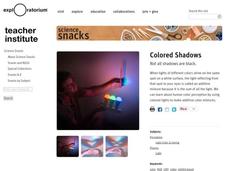Curated OER
20/20 Vision
Learners determine their own eyesight and calculate what a good average eyesight value for the class would be. They examine how technology enhances eyesight and how engineers play an important role in the development of these technologies.
Curated OER
Would You Believe Your Eyes?
Students study the parts and functions of the human eye. They create dodecagons which are twelve-sided figures with twelve equal angles and share these with the class so that each student can begin to see how many different illusions can...
Curated OER
All Those Seeing Color, Say Eye!
Middle schoolers research and discuss the roles of the eye and brain in the perception of color. They watch a slideshow and complete a worksheet.
Curated OER
In the Eyes of the Beholder
Students identify parts of the eye and their functions through participating in a cow's eye dissection lab. They investigate vision problems and diseases, focusing on their causes, and how abnormal vision can be aided with technology.
Curated OER
Hurricane and Tornadoes Group Creative Writing
Creating science literacy through writing gets scholars thinking about the context of scientific terms! Learners collaborate to write a short story about hurricanes and tornadoes in a group. Students have 25 minutes to write the story,...
Curated OER
Sight and Light
Students examine the eyeball and its parts. In this sight lesson students divide into groups and complete a lab activity that includes creating a model.
Curated OER
Technology and the Human Eye
Fifth graders compare technology and the human eye. In this science lesson, 5th graders label the parts of the human eye and trace the path of light as it travels through the eye.
Curated OER
Diseases of the Eye
Fifth graders research diseases of the eye. In this science lesson, 5th graders discuss and research eye diseases and complete a worksheet using the information they find.
Curated OER
Seeing the Way: A Brief History of Cataract Surgery
Students study the eye and how all the parts work together. In this cataract instructional activity students view an interactive website on the eye.
Curated OER
Challenges and Changes: Sensitivity to Vision & Hearing Compromises
Students examine the structure of the eye. In this eye anatomy lesson students complete a lab activity of the human eye.
Curated OER
How We See
Students study how images they see are transmitted to the brain. In this sight activity students complete several activities that have to do with visual pathways and field defects.
Curated OER
Colored Shadows
Students examine how humans perceive color. In this refracted light lesson, students explore the different ways color is seen by the human eye. Students will use colored lights and colored paper and solid objects to make additive color...
Curated OER
Genes
In this genes activity, students answer yes or no to questions about their genes involving their tongue, ears, eyes, and fingers. Students complete 4 questions.
Curated OER
3 Eyes: Print and Color
In this word recognition activity, students trace the word "3 eyes", write the word independently, and color the picture of a creature with 3 eyes.
Curated OER
Eyes: Print and Color
In this word recognition worksheet, students trace the word "eyes," write the word independently, and color the picture of a creature with several eyes.
Curated OER
The Hinode Satellite Views the Sun
In this sun's magnetic field lines worksheet, students use a photograph taken by the Hinode Satellite that shows the complex magnetic structure of the sun over a sunspot. Student predict the magnetic field lines and draw them on a...
Curated OER
"Da" I's Have It: A Fun Look At The Eye
Students study the human eye. In this science lesson plan, students construct 3 models of the human eye and take part in a play that highlights the parts of the eye.
Curated OER
Similar/Different: Nervous System
In this nervous system worksheet, students identify 2 ways that a computer and brain, a telephone wire and the spinal cord and a camera and an eye are similar and different.
Curated OER
Insight Into Eyesight-How We See
In this functions of the human eye activity students label A-E the correct function of each part of the eye on the provided diagram.
Curated OER
How Do People Use Their Parts?
In this senses worksheet, students complete a graphic organizer by describing what a person uses its hands, eyes, mouth, ears, and nose to do.
Curated OER
The Senses
In this senses worksheet, students use the terms listed on the eye to label the figure and describe how light entering the eye becomes an image seen. Then they name the three main sections of the ear and explain what the cochlea does.
Curated OER
Human Face Features
In this artistic worksheet, students decide from a variety of choices how to place on an ordinary face a collection of eyes, lips and noses.
Curated OER
Targeting an Action
Students explore how the brain how the brain infers the position of a moving target. They investigate how the brain can fine-tune its motor control over the muscle groups that will perform the intended action. Students participate in a...
Curated OER
What is the Anatomy of the Visual System?
Students research the structures and functions of the eye. In small groups they dissect a model of the human eye, identify structures of the eye, and describe the functions of the photoreceptors.

























